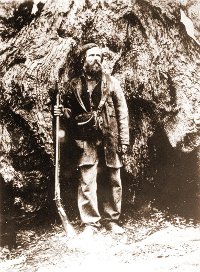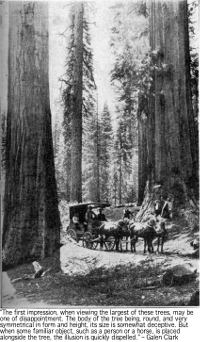Galen Clark: Yosemite's Famous Guardian
One of the first settlers to live in the Yosemite Valley with any kind of permanency was Galen Clark, a Canadian-born carpenter who arrived in the 1850s and stayed for the rest of his life. 
Clark had come to California after his wife, Rebecca, had died at a young age. Clark arrived in California amid Gold Rush fever. When he was 39, in 1853, Clark got a severe lung infection and was told by doctors that he had six months to live. The prescription was to enjoy outdoor air. He moved to what is now Wawona, in Mariposa Grove. Perhaps the most famous residents of Mariposa Grove as the Giant Sequoias, trees that count among Earth's oldest inhabitants. Clark lived a log longer than the six months that doctors had given him. He set up a rest stop for travelers; this came to be known as Clark's Station. also He helped to build what is still today called Pioneer Village. Clark is thought to be the first American who counted and measured the trees in what is now the Wawona settlement. (Wawona is a Native American word thought to have meant "big tree.") 
Clark wasn't all that good at financing and ended up in debt, in 1874 selling his Pioneer Building to a group of brothers in the Washburn family who created what is now Big Trees Lodge. Clark stayed on as guardian, however, a post that he had held, as a representative of the State of California's eight-person commission, since President Abraham Lincoln had in 1964 signed the Yosemite Act, assigning the state to protect the area. A change in government in 1880 ended Clark's guardianship (resulting in the naming of a new guardian, James Hutchings); however, just nine years later, the state turned again to Clark, then 75, to resume his post. He retired as guardian in 1897 but continued to work as a guide. Clark proved much better at caring for the valley and sharing his knowledge with others. Among his more famous visitors who got first-hand tours from Clark were the famed environmentalist John Muir and the well-known author Ralph Waldo Emerson. Galen Clark died on March 24, 1910, and was buried in a grave that he had dug himself, not far from Yosemite Falls; nearby are a granite marker and seedlings from nearby sequoia trees. He was 95. Clark's insights and observations survive in the form of a handful of books that he wrote. Among those are these:
Named after Clark are a Giant Sequoia, a mountain, and a mountain range. His life was the subject of a movie titled Guardian of the Wilderness. |
|
Social Studies for Kids
copyright 2002–2026
David White





